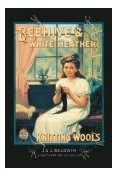The dyeing peg board with 1/2 of the dyed yarn.

The single sock with the afterthought heel just begun and the leftover skein

Tricia led a wonderful class. She is well-organized and very patient -- and remained unflappable for the four or more hours of teaching. She'd also worked out the design of the dyeing peg board in the top picture. A number of already mixed chemical dyes were set out for us to work with. The variety was quite good but I hadn't a clear idea of how to use them, never having done so. That;s why I decided to use a familiar rainbow palette.
Tricia demonstrated how to wind around the pegs to achieve different lengths of color bands. After painting a section, we wrapped it up in cellophane wrap to keep in from bleeding its neighbors. Some bleeding -- see the yellow parts of sock -- had fortuitous results, creating orange from the blending of yellow and red. The dye was set in a microwave.
I was lucky to be working with some very experienced dyers -- Jean S., Jill W. and the owner of a yarn store who also dyes some of her own yarns. Because of their experience with dyeing, they used fewer colors and instead concentrated on mixing gradations of shades and tones of two or three. But, I'm pleased to have learned the technique. I've volunteered the sock, yarn and dyeing board for use at the Guild's display at Garden State Sheep Breeders. When I retrieve the board I will play with this technique again.
I'm just now finishing the sock -- a plain tube of 64 stitches with an afterthought heel. This is my first attempt at this heel, also known as a peasant heel. The sock is small and the fabric is dense. For a stretchier sock I'd use a #2 needle for the KnitPicks sock yarn for dyeing.

No comments:
Post a Comment